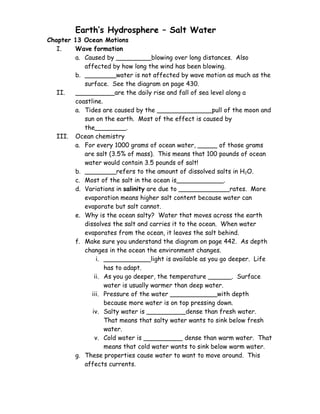
Salt water notes with blanks(ch13, 14)andie
- 1. Earth’s Hydrosphere – Salt Water Chapter 13 Ocean Motions I. Wave formation a. Caused by _________blowing over long distances. Also affected by how long the wind has been blowing. b. ________water is not affected by wave motion as much as the surface. See the diagram on page 430. II. __________are the daily rise and fall of sea level along a coastline. a. Tides are caused by the ______________pull of the moon and sun on the earth. Most of the effect is caused by the________. III. Ocean chemistry a. For every 1000 grams of ocean water, _____ of those grams are salt (3.5% of mass). This means that 100 pounds of ocean water would contain 3.5 pounds of salt! b. ________refers to the amount of dissolved salts in H2O. c. Most of the salt in the ocean is____________. d. Variations in salinity are due to _____________rates. More evaporation means higher salt content because water can evaporate but salt cannot. e. Why is the ocean salty? Water that moves across the earth dissolves the salt and carries it to the ocean. When water evaporates from the ocean, it leaves the salt behind. f. Make sure you understand the diagram on page 442. As depth changes in the ocean the environment changes. i. ____________light is available as you go deeper. Life has to adapt. ii. As you go deeper, the temperature ______. Surface water is usually warmer than deep water. iii. Pressure of the water ____________with depth because more water is on top pressing down. iv. Salty water is __________dense than fresh water. That means that salty water wants to sink below fresh water. v. Cold water is __________ dense than warm water. That means that cold water wants to sink below warm water. g. These properties cause water to want to move around. This affects currents.
- 2. IV. Ocean currents a. An ocean current is a “__________” of moving water with the ocean. An example would be the Atlantic Gulf Stream. The water in the current has the same properties and does not mix much with the rest of the ocean. b. All ocean currents flow in predicable patterns. c. Surface currents, like waves, are driven and determined by wind and the _________ ________(be able to explain the Coriolis effect). d. Ocean currents can affect ____________by warming or cooling the air above the current. Example – England is warmer that it should be based on its latitude because of the Gulf Stream current coming from the southern USA. See map page 447. Chapter 14 Ocean Zones V. New technology has been developed to explore the ocean floor. (see pages 460-1) Know the following and how we use that technology: a. SCUBA b. Sonar c. Submersibles d. Satellites VI. Feature of the ocean floor – know all the ones described in your book on pages 462 to 464. a. Continental shelf b. Continental slope c. Abyssal Plain d. Mid-ocean ridge e. Seamount f. Trench VII. Life in the ocean a. ___________– small organisms that float and are carried by waves and currents. b. _________ – free swimming – they can choose where to go. c. _________ – inhabit the ocean floor (crawl, walk, attached) d. ___________zone (See pages 468-469) – Where the waves are lapping, water is coming and going. It is found between the
- 3. high tide line and the low tide line. Very difficult ecosystem in which to live.